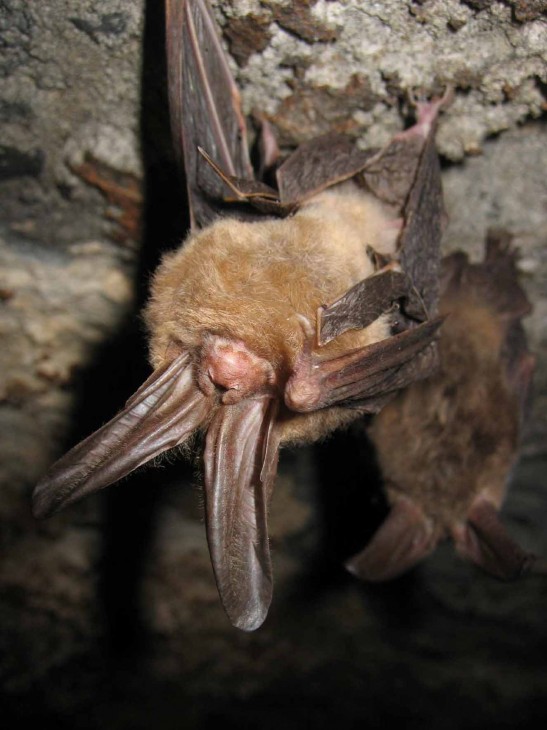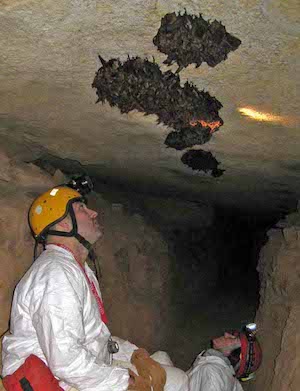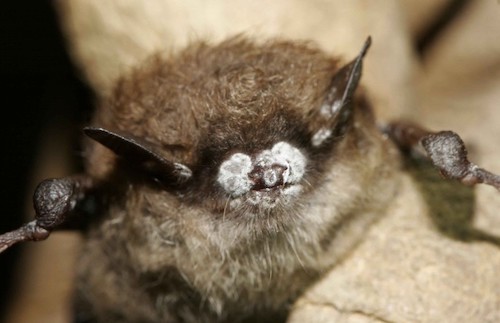Bats are Gardeners’ Friends
by Carolyn R. Casey, Fairfax Master Gardener
 At sunset around dusk, I was studying the beautiful evening Virginia sky when a dark shadowy creature flew by. Known as the common everyday bat, a great insect predator, it caught my attention flying reconnaissance flights over my backyard. I marveled at its aerial acrobatics flying like a stealth bomber very close to the ground and wonder why it was there. For years I have marveled at this gardener’s friend, a homely bat. There are many horror and fictional stories about bats that have created fear, confusion and misunderstanding in people. Bats actually are beneficial to gardeners, homeowners and nature.
At sunset around dusk, I was studying the beautiful evening Virginia sky when a dark shadowy creature flew by. Known as the common everyday bat, a great insect predator, it caught my attention flying reconnaissance flights over my backyard. I marveled at its aerial acrobatics flying like a stealth bomber very close to the ground and wonder why it was there. For years I have marveled at this gardener’s friend, a homely bat. There are many horror and fictional stories about bats that have created fear, confusion and misunderstanding in people. Bats actually are beneficial to gardeners, homeowners and nature.
You might enjoy walking in your yard and working in your garden. Do you find it doesn’t seem to matter what time of day, when you are outside you are constantly being bitten by annoying mosquitoes and your garden is being eaten by insects? Then you may want to try attracting a lesser known natural predator to your yard to help you with these problems. Some bats can eat 50 to 75 percent of their body weight each night; eating up to several thousand insects every night – insect pests as well as beneficial insects. The jury is still out among researchers, however, as to whether bats are effective control for mosquitoes.

Hanging Virginia Big-Eared Bat
There are over 1,000 species of bats in the world and most live in the tropics. There are 45 species of bats in North America; 19 are found in the eastern United States, and 17 have been known to live in Virginia. In 2005 the Virginia big-eared bat was chosen as the Virginia state bat. Each year there is an International Bat Appreciation Day on April 17.
Bats are mammals that belong to the class Mammalia. They give birth to their young, feed their young with milk and grow hair. Bats are the only mammals that are able to sustain flight. They have their own order, Chiroptera, that means “hand wing.” When looking at the bat’s wing, you notice that it is half arm and half hand. The bat’s upper arm and forearm are relatively proportional to its body. They have elongated fingers that they can move independently of one another. They even have a belly button. They live for about 20 years.
They have the ability to hover in place, fly backwards, stoop, dive and roll as needed. They use these maneuvers when pursuing their meals of moths, mosquitoes and other insects. Some species can attain speeds up to 100 miles per hour. Bats clean themselves, and some species will clean each other. Bats do have a few natural predators; they are owls, hawks and snakes.
Because bats eat many agricultural pests, they have earned the title of the farmers’ best friend. They eat June beetles, click beetles, leafhoppers, plant hoppers, spotted cucumber beetles, green stinkbugs and corn earworm moths. This saves farmers an estimated 3.7 billion dollars a year and saves the environment from all those chemicals that would have been used to control these insects.
Scientists put bats into two major groups, the Megachiroptera and the Microchiroptera.
Megachiroptera bats are known as fruit eating bats or flying foxes. These groups of bats are usually found in southeast Asia, Australia and the southwest Pacific. They have big eyes, smaller ears in comparison to their heads, and their faces look like dogs. They are large and can have a 6-foot wingspan. Since this group of bats eats fruit, they use their sense of smell and sight instead of echolocation to locate food. Megachiroptera bats fertilize and distribute seeds of several plants and trees. This group of bats promotes the creation of cashew, breadfruit, plantain, guava, fig, clove, mango, balsa wood, banana and peach trees.
Microchiroptera bats eat insects and are the majority of bats in North America. They have small eyes, large ears in comparison to the size of their heads and have pug-like faces. They are usually small and have a wingspan of 2 feet (60 cm) or less. These bats use echolocation to locate their food.

Cave researching Virginia bats
Virginia bats use echolocation, the emitting of high frequency pulses that are emitted through a bat’s mouth or nose. These pulses travel out, bounce off of an object and return to the bat. The bat’s ears are able to sense the differences in time needed for the acoustic pulse to return to each ear. This tells the bat the direction of the object and the time needed for the echolocation pulse to return. It also tells the bat how far away the object is. The pulse helps the bat determine the distance, size and direction of objects. Bats can vary the frequency of echolocation pulses they emit depending on their activity. When a bat is hunting for its dinner, it increases the number of pulses emitted as they get closer to its prey.
Not all bats hibernate; some migrate. Spotted bats migrate to warmer climates in search of food when it gets cold. The ones that do hibernate overwinter in trees or caves. Tree bats hibernate in the cavities of trees, in wood piles, loose rock, in rock crevices and sometimes in caves. They have tails that are fully furred that they use as a coat when it gets cold. Tree bats are usually solitary bats during hibernation and maternity seasons. After giving birth to twins, the female tree bat will usually bring up its young independently while hanging in the dense foliage in trees. There are a few tree bats that can give birth to up to four young. Baby bats are called pups.
Bats that hibernate in caves usually live in large clusters, by themselves or in small groups. In the summer, female bats create small maternity colonies and bring up their pups under the loose bark of trees. Female cave bats give birth to only one pup a year.
It is illegal to transport, release or relocate a bat anywhere other than the property where it was caught. It is also illegal to poison bats. There are three species of bats that are found in Virginia that are federally endangered and are protected under the Endangered Species Act. It explicitly prohibits anyone from attempting to “harass, harm, pursue, hunt, shoot, wound, kill, trap, capture or collect, or to attempt to engage in any such conduct” any endangered or threatened species.
The three federally endangered species of bat in Virginia are Gray Bat, Indiana Bat and Virginia Big-eared Bat. Before implementing any control technique, ensure that your problem bat is not one of these endangered species. The Northern Long-eared Bat is federally threatened while the Rafinesque’s Big-eared Bat, Little Brown Bat, and Tri-colored Bat are state endangered. The remaining bats are non-game protected species in Virginia. Less than 0.5 to 1 percent of all bats carry rabies.

White-nose Syndrome
Since 2009, several populations of cave dwelling bat species in Virginia have been decimated by White-nose Syndrome (WNS). It is a disease caused by the pathogenic fungus Pseudogymnoascus destructans. Cavers should avoid concentrations of hibernating bats because they may be the last hope for the survival of several species. If concentrations of hibernating bats are observed, they need to be reported to Wil.Orndorff@dcr.virginia.gov so that they can be tracked and protected.
Cavers should not wear or take clothing and equipment used in Virginia caves into areas where WNS is not known and abide by local decontamination protocols. Pseudogymnoascus destructans spores are likely present in all Virginia caves; it is believed that bats are the primary vector spreading WNS. It is also believed that the disease is spread by cavers by way of contaminated gear and clothing.
The development of wind energy facilities has led to significant bat fatalities. This has concerned scientists since each turbine is expected to operate for 20 to 30 years. After further studies, it was found that most fatalities happened when the turbines were operating at low wind speeds. It was decided that there would be a decrease in bat fatalities if turbines were not operating at night under certain seasonal and weather conditions.
The study of bats has helped man acquire valuable knowledge about sonar, coagulation in blood, vaccine development and artificial insemination. Bats pollinate plants that depend on them for their survival. These plants are used to produce 80 different kinds of medicines. The echolocation used by bats has help scientists create navigational aids for blind people.
Remember to mark your calendars for International Bat Appreciation Day on April 17. Bats are our friends and make great neighbors! One should welcome bats to your gardens for many good reasons. Happy Gardening!
Resources
• Bats working with Wildlife, Christopher Moorman, Mark Megalos, Liessa Bowen, NC State Extension
• A Guide to the Bats of Virginia, Virginia Department of Wildlife Resources
• Bats, Virginia Department of Wildlife Resources
• Bats of Virginia, Virginia Department of Conservation and Recreation
• WVU Extension Service expert says bats are more than just a spooky symbol, Sheldon Owen, West
Virginia University Extension
• Bat Management & Conservation, Virginia Department of Wildlife Resources
• 13 Awesome Facts About Bats, U.S. Department of the Interior
• Bats & Mosquitoes, Bat Conservation International